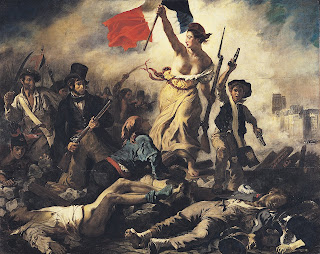The Barbizon school (1830–1870) of painters is named after the village of Barbizon near Fontainebleau Forest, France, where the artists gathered. The Barbizon painters were part of a movement towards realism in art which arose in the context of the dominant Romantic Movement of the time. In 1824 the Salon de Paris exhibited works of John Constable. His rural scenes influenced some of the younger artists of the time, moving them to abandon formalism and to draw inspiration directly from nature. Natural scenes became the subjects of their paintings rather than mere backdrops to dramatic events. During the Revolutions of 1848 artists gathered at Barbizon to follow Constable's ideas, making nature the subject of their paintings. One of them, Jean-François Millet, extended the idea from landscape to figures — peasant figures, scenes of peasant life, and work in the fields. In The Gleaners (1857), Millet portrays three peasant women working at the harvest. There is no drama and no story told, merely three peasant women in a field. The leaders of the Barbizon school were Jean-Baptiste Camille Corot, Théodore Rousseau, Jean-François Millet and Charles-François Daubigny; other members included Jules Dupré, Narcisse Virgilio Diaz, Charles Olivier de Penne, Henri Harpignies, Gabriel Hippolyte LeBas (1812-1880), Albert Charpin, Félix Ziem, François-Louis Français and Alexandre DeFaux.
| The Gleaners (1857) by Jean François Millet |
Barbizon School (1830-1870)


.jpg)

